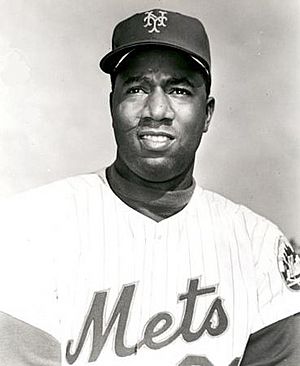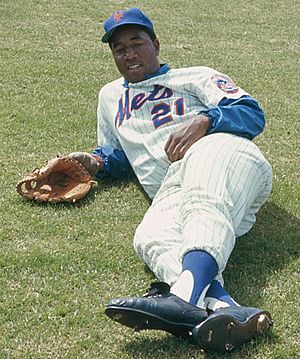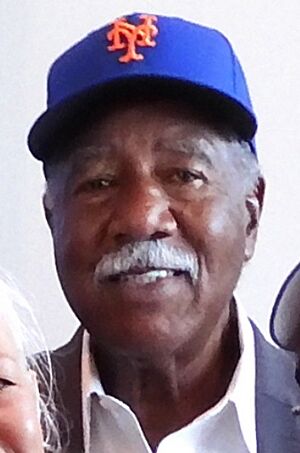Cleon Jones facts for kids
Quick facts for kids Cleon Jones |
|||
|---|---|---|---|
 |
|||
| Left fielder | |||
| Born: June 24, 1942 Mobile, Alabama, U.S. |
|||
|
|||
| debut | |||
| September 14, 1963, for the New York Mets | |||
| Last appearance | |||
| May 1, 1976, for the Chicago White Sox | |||
| MLB statistics | |||
| Batting average | .281 | ||
| Home runs | 93 | ||
| Runs batted in | 524 | ||
| Teams | |||
|
|||
| Career highlights and awards | |||
|
|||
Cleon Joseph Jones (born June 24, 1942) is an American former professional baseball player. He played as a left fielder in Major League Baseball. Jones spent most of his career with the New York Mets. In 1969, he caught the final out of the "Miracle Mets" World Series Championship. This was a huge win against the Baltimore Orioles.
Contents
Cleon Jones' Baseball Journey
Starting in the Minor Leagues
Cleon Jones played both football and baseball in high school in Mobile, Alabama. He also played baseball for the Grambling State Tigers.
In 1962, Jones signed with the New York Mets. He played well in the minor leagues, hitting over .300. Because of his great play, he was called up to the major leagues in September 1963. This was a big step, as he skipped some higher minor league levels.
In 1964, he played for the triple-A Buffalo Bisons. He then made the Mets team in 1965. He hit his first major league home run on September 22, 1965.
Playing for the New York Mets
In 1966, Jones became the starting center fielder for the Mets. He had a good year, hitting .275 with eight home runs. He also had 57 runs batted in (RBIs) and 16 stolen bases. He finished fourth in the voting for National League Rookie of the Year.
In 1967, his batting average dropped a bit. The Mets then got his childhood friend, Tommie Agee, who was a great fielder. Jones moved to left field, and Agee played center field.
By 1968, Jones started to play much better. He ended the season with a .297 batting average. This was the sixth best in the National League.
The Amazin' Mets of 1969
The 1969 season was amazing for Cleon Jones and the Mets. Jones was hitting .341 with ten home runs and 56 RBIs by mid-season. This earned him a spot as the starting left fielder in the All-Star Game. He played well in the game, helping the National League win.
The Mets were a surprising team, often called the "Amazin' Mets." They were in second place in their division.
A Key Moment in 1969
On July 30, 1969, during a game against the Houston Astros, something important happened. The Mets were losing badly. After a play, Mets manager Gil Hodges walked out to left field to talk to Jones. A few minutes later, Jones left the game.
Years later, Jones explained what happened. He said Hodges asked him about his effort on a play. Jones told Hodges his leg was hurting and the field was wet. Hodges understood and agreed Jones should not be playing. They walked off the field together. Jones felt this moment showed the team that their manager expected everyone to give their best effort. Many believe this incident helped the Mets focus and play even harder.
Becoming World Series Champions
After that moment, the Mets played incredibly well. They won 38 of their last 50 games. They finished the 1969 season with 100 wins. This was eight games better than the second-place Chicago Cubs.
Jones finished the season with a .340 batting average. This was the third best in the league. He was also second on the team in home runs, RBIs, and runs scored.
The Mets then swept the Atlanta Braves in the 1969 National League Championship Series. Jones hit .429 in that series.
The Mets were not expected to win the 1969 World Series against the Baltimore Orioles. But they took a 3–1 lead in the series. In Game 5, Jones was hit by a pitch. The umpire first said it missed him. But Gil Hodges showed the umpire the ball with a shoe-polish smudge. The umpire changed his call, and Jones went to first base. The next batter, Donn Clendenon, hit a two-run home run. This helped the Mets get back into the game.
The Mets went on to win Game 5, and the World Series! In the ninth inning, with the Mets leading, Orioles player Davey Johnson hit a fly ball. Cleon Jones caught it near the warning track. This catch sealed the World Series victory for the Mets. It was an unforgettable moment.
Later Years with the Mets
In 1971, Jones had another great year, hitting .319.
In 1973, Jones helped the Mets win their division title. He hit six home runs in the last ten games of the season. The Mets then upset the Cincinnati Reds in the 1973 National League Championship Series.
The Mets played in the 1973 World Series against the Oakland Athletics. They lost in seven games. Jones batted .286 in the series and hit a home run in Game 2.
A Difficult Situation in 1975
In 1975, Cleon Jones faced a difficult situation. He was arrested in Florida. The charges were later dropped. However, the New York Mets fined him $2,000. He also had to apologize publicly. Jones apologized with his wife, Angela, by his side. They have been married for over 50 years.
Retirement from Baseball
Jones rejoined the Mets in May 1975. He was released by the Mets in July after a disagreement with manager Yogi Berra. In 1976, he played briefly for the Chicago White Sox. He retired after playing 13 games with them.
Cleon Jones was known for having one of the strongest arms in the National League as an outfielder. He had 64 outfield assists during his career.
After retiring, Jones worked for the New York Mets as a minor-league hitting coach. He helped many young players, including Kevin Mitchell, who later helped the Mets win the 1986 World Series.
Honors and Recognition
Cleon Jones was inducted into the New York Mets Hall of Fame in 1991. His .340 batting average in 1969 was a team record for many years. He is still one of the Mets' all-time leaders in games played, at-bats, and hits.
He is also a member of the Alabama Sports Hall of Fame and the Mobile Sports Hall of Fame.
In 2012, Jones was chosen as the Mets' "All-Time Leftfielder." In November 2021, he was inducted into the New York State Baseball Hall of Fame. His wife, Angela, was with him for this honor.
Life After Baseball
Cleon Jones has appeared on TV shows, including an episode of Everybody Loves Raymond in 1999. He was also mentioned in the movie Men in Black 3, which showed his famous catch from the 1969 World Series.
Today, Jones lives in his hometown of Mobile, Alabama. He and his wife, Angela, work to fix up homes for older residents in the Africatown area of Mobile.
In August 2022, Jones published his autobiography titled Coming Home: My Amazin' Life with the New York Mets.



